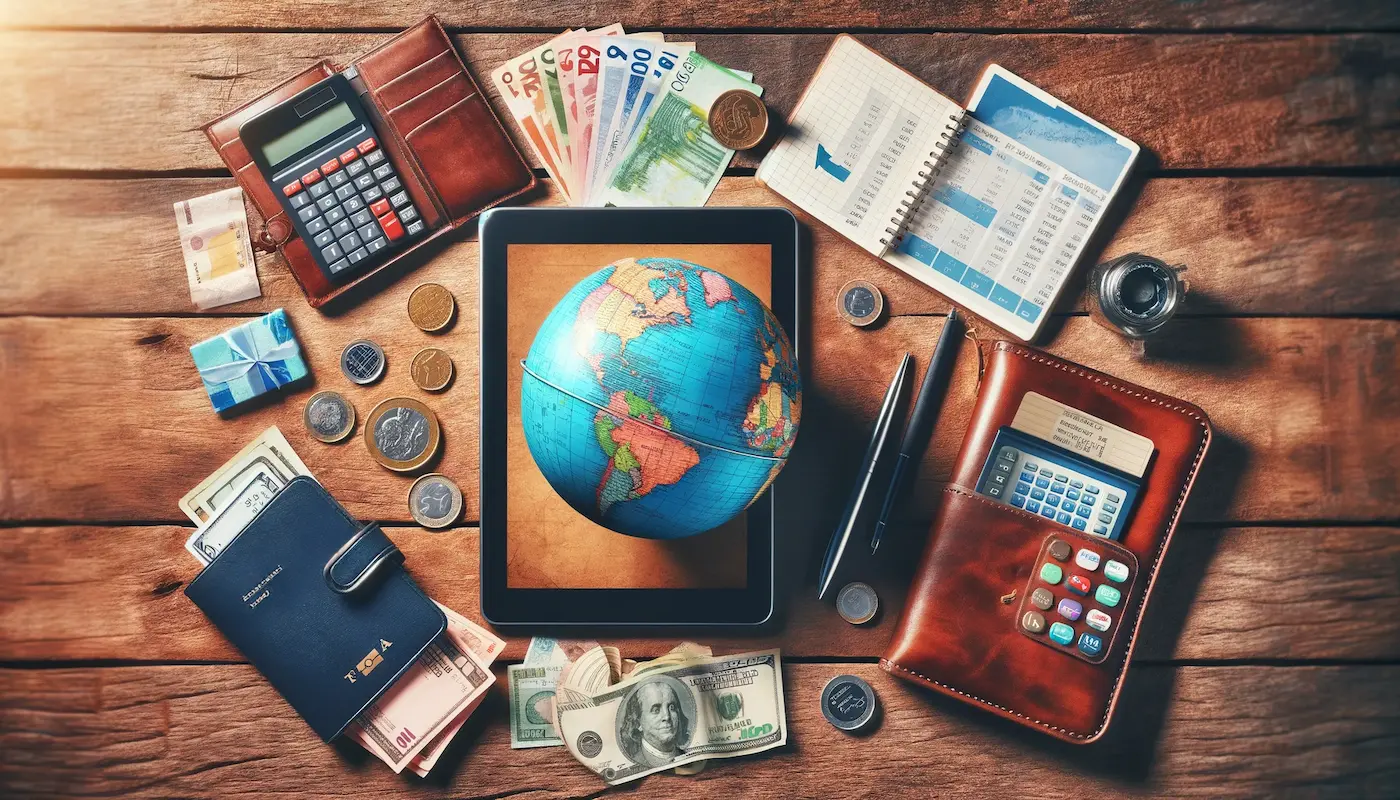How to travel full time ?


Embrace the rhythm of the nomadic lifestyle, where each sunrise heralds a new adventure and home is wherever your heart wanders. Let’s see how to travel full time, a journey that transforms the globe into your backyard.
Table of Contents
Toggle
Understanding the Full Time Travel Lifestyle
Full time travel is more than a mere departure from the norm; it’s an entire redefinition of ‘normal.’
It’s about trading the traditional brick-and-mortar existence for a life where change is the only constant, and home is a concept rather than a place.
This lifestyle isn’t just about seeing new places; it’s about fully immersing yourself in diverse cultures, forming connections across continents, and growing through the myriad experiences that only travel can offer.
1. Defining Full Time Travel
At its core, full time travel means living in a way that your movement across the globe isn’t dictated by vacation days or return tickets.
Whether it’s roaming with a backpack, living out of a suitcase, or driving a home-on-wheels, full time travel can take many forms.
It’s about embracing a life where every day is an opportunity to explore, learn, and create memories.
2. Types of Full Time Travelers
- Solo Wanderers: For those who crave solitude and self-discovery, traveling solo can be a profoundly liberating experience.
- Couples: Partners embarking on this journey together find that full time travel can strengthen relationships, forging unbreakable bonds through shared adventures.
- Families: More families are choosing to educate their children through global exposure, valuing real-world experiences over traditional schooling.
- Digital Nomads: Leveraging technology to work remotely, digital nomads blend productivity with the freedom to explore, turning the world into their office.
3. Lifestyle Insights
- Pros:
- Freedom and Flexibility: Decide your own schedule, destinations, and pace.
- Enhanced Learning: Exposure to different cultures, languages, and histories.
- Personal Growth: Overcoming challenges and stepping out of comfort zones leads to self-discovery and resilience.
- Cons:
- Uncertainty and Instability: Constant change can lead to a sense of rootlessness.
- Logistical Challenges: Managing visas, healthcare, and finances on the go.
- Social Sacrifices: Being away from friends and family for extended periods.
As we peel back the layers of full time travel, it’s clear that this lifestyle isn’t just about the places you visit; it’s about the person you become in the process.
It’s a commitment to living life as a journey, not a destination. In the following sections, we’ll navigate through the practicalities and preparations necessary to embark on this life-altering adventure.
Stay tuned as we explore the financial, logistical, and emotional facets of how to travel full time.

Financial Planning and Budgeting
Embarking on a full time travel adventure requires more than just a thirst for adventure; it necessitates a solid financial strategy.
Whether you’re roaming through cities or venturing into the wilderness, understanding and managing your finances is crucial.
This section will guide you through saving for your journey, budgeting on the go, and sustaining your travels through various income streams.
1. Saving for Your Journey
- Assess Your Financial Health: Before setting off, take a comprehensive look at your financial situation—debts, savings, and monthly expenses.
- Set a Savings Goal: Estimate your initial travel budget, considering factors like destinations, travel style, and duration. Then, work backward to set a realistic savings target.
- Cut Unnecessary Expenses: Analyze your current spending and identify areas where you can cut back. Small savings can add up significantly over time.
- Create a Separate Travel Fund: Open a savings account dedicated to your travel fund to avoid the temptation of dipping into it for other expenses.
2. Budgeting on the Road
- Track Your Spending: Keep a close eye on your daily expenses. Tools and apps designed for travelers can help you monitor and categorize your spending.
- Adopt a Frugal Mindset: Embrace cost-saving practices like choosing budget accommodations, eating like a local, and using public transportation.
- Plan Major Expenses in Advance: Flights, insurance, and visas can be significant expenses. Plan and book these in advance to avoid last-minute price surges.
3. Sustaining Your Travels: Income Streams
- Remote Work: If your job allows, negotiate a remote work arrangement. Alternatively, seek freelance opportunities that align with your skills (writing, design, coding, etc.).
- Teaching English: Certified travelers can find opportunities worldwide to teach English, either in-person or online.
- Seasonal Jobs: Engage in seasonal work like fruit picking, hostel work, or ski instructing, depending on your location and the time of year.
- Passive Income: If possible, establish sources of passive income before you leave, such as rental properties, stock dividends, or online businesses.
Financial planning and budgeting might not be the most exhilarating part of travel, but they are undoubtedly the backbone of a sustainable nomadic lifestyle.
With a sound financial plan, the world is truly your oyster.
Up next, we’ll discuss how to prepare for your journey, ensuring that you’re ready for the myriad of adventures that full time travel brings

Preparing for the Journey
Transitioning to a full time travel lifestyle isn’t just about financial preparation; it involves a comprehensive approach to ensure a smooth journey ahead.
From securing important documents to deciding what to pack, this section covers the essentials you’ll need to address before hitting the road.
1. Research and Documentation
- Understand Visa Requirements: Research the visa requirements for your intended destinations well in advance. Some visas can be obtained upon arrival, while others may require a lengthy application process.
- Acquire Necessary Permits: Depending on your destinations, you might need specific permits for activities like trekking, driving, or even volunteering.
- Secure Travel Insurance: Opt for a reliable travel insurance plan that covers medical emergencies, trip cancellations, and lost belongings.
2. Health and Safety
- Visit a Travel Clinic: Get necessary vaccinations and health advice based on your itinerary. Keep a record of your vaccinations with your travel documents.
- Prepare a First-Aid Kit: Pack a travel-sized first-aid kit with essentials like band-aids, antiseptic wipes, and prescription medications.
- Stay Informed: Keep up-to-date with the political situation, cultural norms, and safety conditions of your destinations.
3. Managing Your Belongings
- Downsize Your Possessions: Full time travel means living minimally. Sell, donate, or store belongings that you won’t need on the road.
- Secure Your Home Base: If you’re keeping a property, ensure it’s secure or rented out. Manage bills, mail, and other responsibilities that might need attention while you’re away.
4. Packing Essentials
- Choose the Right Luggage: Opt for durable, lightweight luggage. Backpacks are preferable for flexibility and mobility, while suitcases might be suitable for more stationary lifestyles.
- Pack Smart: Focus on multi-functional clothing and essentials. Remember, almost everything can be bought or replaced on the road.
- Tech and Connectivity: Pack necessary gadgets, chargers, and adapters. Consider a reliable portable Wi-Fi device if you plan to work or need consistent internet access.
5. Setting Up for Remote Work
- Establish a Workflow: If you’re working while traveling, set up a remote work routine with tools and apps that keep you organized and connected.
- Communicate with Employers/Clients: Ensure clear communication about your travel plans and how it might affect your work schedule, especially across different time zones.
Preparing for full time travel is as much about anticipation as it is about organization.
By taking care of these essentials, you’re setting the stage for a smoother and more enjoyable journey.
Up next, we’ll dive into choosing your destinations and planning your itineraries, ensuring your travel saga is both thrilling and fulfilling.

Choosing Destinations and Planning Itineraries
The world is vast, and the possibilities for exploration are nearly endless.
Choosing your destinations and planning your itineraries are exciting steps in your full time travel journey, but they also require thoughtful consideration to align with your interests, budget, and the lifestyle you wish to maintain.
This section will help you navigate these decisions, ensuring your travels are not just spontaneous but also deeply fulfilling.
1. Selecting Your Destinations
- Follow Your Interests: Whether it’s history, nature, cuisine, or culture, let your passions guide your destination choices.
- Consider the Seasons: Research the best time to visit each destination, considering factors like climate, tourist seasons, and local festivals or events.
- Be Open to Off-the-Beaten-Path Locations: Sometimes, the most memorable experiences come from the places you least expect. Don’t be afraid to explore less popular destinations.
2. Itinerary Planning
- Balance Structure with Spontaneity: While it’s important to have a plan, allow room for spontaneous adventures and changes based on your experiences and interactions.
- Stay Longer in Each Location: Embrace slow travel by spending more time in each place. This allows for a deeper understanding of the culture and can also be more cost-effective.
- Be Mindful of Travel Fatigue: Constant movement can be exhausting. Plan for periods of rest and relaxation to recharge and reflect on your experiences.
3. Accommodation and Transportation
- Book in Advance Where Necessary: For popular destinations or during peak seasons, it’s wise to book your accommodations and transportation in advance.
- Embrace Local Experiences: Consider homestays, local guesthouses, or community-based tourism initiatives that offer a more authentic and potentially more sustainable travel experience.
- Explore Different Modes of Transportation: Depending on the region, you might find that buses, trains, bikes, or even boats are not only cost-effective but also enriching ways to travel.
4. Local Knowledge and Connections
- Engage with Local Communities: Interacting with locals can provide insights and recommendations that you won’t find in guidebooks.
- Use Technology Wisely: Leverage apps and online platforms for recommendations, navigation, and even language translation to enhance your travel experience.
- Be Respectful and Culturally Sensitive: Always approach new cultures with respect and an open mind. Learn about local customs, traditions, and etiquette to ensure your interactions are positive and respectful.
By carefully choosing your destinations and thoughtfully planning your itineraries, you set the stage for a journey that’s not just about the places you visit but about the stories you collect and the growth you experience along the way. Next, we’ll look into the essentials of packing, ensuring you’re well-equipped for your full time travel adventure.

Packing Essentials and Gear
Packing for full time travel is an art form, requiring a delicate balance between preparedness and minimalism.
It’s about ensuring you have everything you need to be comfortable and safe, without being weighed down by unnecessary items.
This section will guide you through selecting the essentials, making smart packing choices, and recommending gear that can make your life on the road both efficient and enjoyable.
1. Choosing the Right Luggage
- Backpack vs. Suitcase: Consider your travel style and destinations when choosing between a backpack and a suitcase. Backpacks offer mobility and are ideal for less accessible locations, while suitcases might be suitable for more urban, long-term stays.
- Durability and Size: Opt for high-quality, durable luggage that can withstand the rigors of constant travel. Keep size in mind—larger isn’t always better, especially when you’re constantly on the move.
2. Clothing and Footwear
- Versatile Clothing: Choose clothing that’s versatile, easy to layer, and suitable for various climates. Neutral colors can mix and match easily, maximizing your outfit options.
- Quality Footwear: Invest in a good pair of comfortable, durable shoes suited to a range of activities. Consider the terrain and climate of your destinations when choosing your footwear.
3. Tech and Gadgets
- Essential Electronics: A smartphone, camera, laptop or tablet, and the necessary chargers and adapters are often essential for both work and staying connected.
- Power Solutions: A portable power bank and a universal travel adapter ensure your devices stay charged, no matter where you are.
4. Health and Hygiene
- Travel-Sized Toiletries: Opt for travel-sized containers for your toiletries or purchase them as you go to save space and weight.
- First-Aid Kit: A basic first-aid kit with band-aids, pain relievers, and any personal medication is a must-have.
5. Travel Extras
- Packing Organizers: Compression sacks, packing cubes, or even simple ziplock bags can help organize and compress your belongings.
- Security Items: Consider items like a money belt, padlocks, and a small flashlight for security and convenience.
- Entertainment: Books, e-readers, or a compact travel journal can be great for downtime or long transit days.
Remember, the goal of packing for full time travel is not to prepare for every possible scenario but to be equipped for a variety of situations with as little baggage as possible.
Each item you pack should earn its place in your luggage through utility and versatility. With your bags packed and your spirit ready for adventure, you’re one step closer to embarking on your full time travel journey.
Next, we’ll discuss how to stay connected and manage the logistical aspects of life on the road

Staying Connected
In today’s digital age, staying connected while traveling full time is not only a convenience but often a necessity, especially if you’re working remotely or wish to keep in touch with family and friends.
This section covers the essentials of maintaining connectivity, managing work, and leveraging technology to enhance your travel experience.
1. Internet Access
- Local SIM Cards: Purchasing a local SIM card can provide you with data and connectivity at local rates. Ensure your phone is unlocked before your journey.
- Wi-Fi Hotspots: Cafes, libraries, and co-working spaces are great places to find Wi-Fi. Be cautious about security when using public networks and consider using a VPN for added protection.
- Portable Wi-Fi Devices: A portable Wi-Fi device can offer a more consistent and secure internet connection in various locations.
2. Remote Work Management
- Establish a Routine: Find a work routine that fits your travel schedule. Consistency can help you stay productive and balance work with exploration.
- Time Zone Coordination: Be aware of time zone differences when scheduling meetings or deadlines. Tools like time zone converters can be invaluable for managing these differences.
- Backup Plans: Have contingency plans for deadlines or meetings in case of unreliable internet or unforeseen circumstances.
3. Communication Tools
- Messaging and Video Calls: Apps like WhatsApp, Skype, and Zoom are essential for staying in touch with loved ones and colleagues.
- Social Media: Platforms like Instagram, Facebook, or a personal blog can be great ways to share your experiences and stay connected with a broader audience.
- Data Backup: Regularly back up your data, photos, and important documents on cloud services or external hard drives to prevent loss.
4. Leveraging Technology
- Travel Apps: Utilize travel apps for navigation, language translation, budget tracking, or finding accommodations and local experiences.
- E-Readers and Online Libraries: Save space and weight by bringing digital versions of your favorite books for entertainment and learning.
- Online Learning: Platforms like Coursera, Udemy, or Duolingo can help you learn new skills or languages, enriching your travel experience.
Staying connected while traveling full time allows you to blend the freedom of travel with the responsibilities of daily life seamlessly.
It opens doors to remote work opportunities, enhances your travel experience through technology, and keeps you linked to the people and places that matter most.
As you journey across the globe, technology can be your ally, ensuring that no matter where you roam, you’re never truly disconnected.
Next, we’ll tackle the challenges of full time travel and provide tips for staying safe and maintaining your well-being on the road.

Dealing with Challenges and Staying Safe
Full time travel is an incredibly rewarding experience, but it’s not without its challenges.
From navigating unfamiliar environments to dealing with unexpected setbacks, the nomadic lifestyle can test your resilience.
This section offers practical advice for overcoming common obstacles and ensuring your safety and well-being as you traverse the globe.
1. Overcoming Common Challenges
- Cultural Shock and Adaptation: Embrace new cultures with an open mind. Learning a few phrases in the local language, understanding cultural norms, and showing respect can go a long way in smoothing interactions.
- Homesickness: Staying in touch with loved ones and creating a network of fellow travelers can help mitigate feelings of loneliness and disconnection.
- Burnout: Travel can be exhausting. Recognize the signs of burnout and give yourself permission to rest and recharge when needed.
2. Health and Well-Being
- Maintain a Healthy Lifestyle: Find a balance between indulging in local cuisine and maintaining a healthy diet. Incorporate physical activity into your routine, whether it’s a daily walk, yoga, or a more adventurous activity.
- Mental Health: The highs and lows of travel can impact your mental health. Practice mindfulness, keep a journal, or find other ways to process your experiences and emotions.
- Medical Care: Know how to access medical care on the road. Keep a list of emergency contacts and understand your health insurance coverage abroad.
3. Safety Precautions
- Stay Informed: Keep up-to-date with local news and safety advisories. Register with your embassy if traveling in less stable regions.
- Secure Your Belongings: Use luggage locks, money belts, or anti-theft backpacks. Be cautious with your valuables, especially in crowded or unfamiliar places.
- Trust Your Instincts: If a situation feels unsafe or uncomfortable, trust your instincts and remove yourself from it.
4. Problem-Solving on the Go
- Stay Calm and Resourceful: Challenges are inevitable. Maintain a calm, problem-solving mindset to navigate through unexpected situations.
- Build a Support Network: Connect with fellow travelers, expat communities, or local friends who can offer advice and support.
- Know When to Seek Help: Don’t hesitate to reach out to local authorities, your embassy, or travel insurance provider in case of serious issues.
Traveling full time is a journey of constant learning and adaptation.
By preparing for challenges and prioritizing your safety and well-being, you can navigate the complexities of the nomadic lifestyle more confidently.
Embrace each hurdle as an opportunity for growth and each triumph as a testament to your resilience.
In the next section, we’ll explore the importance of building a community on the road, ensuring that wherever you go, you’re part of a global network of wanderers and dreamers like yourself.

Building a Community
While full time travel offers unparalleled freedom and adventure, it can also be a solitary journey at times.
Building a community of like-minded individuals can enrich your travel experience, providing support, friendship, and shared memories.
This section discusses ways to meet people, form connections, and become part of a global community of travelers.
1. Leveraging Social Media and Online Platforms
- Join Travel Groups and Forums: Platforms like Facebook, Reddit, and specialized travel forums host vibrant communities where you can ask for advice, share experiences, and meet fellow travelers.
- Use Travel Apps: Apps like Meetup, Couchsurfing, or Travello can connect you with local events or fellow travelers in the area.
- Share Your Journey: Starting a blog or a social media channel not only allows you to document your travels but also attracts like-minded individuals who resonate with your journey.
2. Engaging with Local Communities
- Participate in Local Events and Activities: Attend cultural events, festivals, or language exchange meetups to immerse yourself in the local culture and meet residents and travelers alike.
- Volunteer: Engaging in volunteer work can be a meaningful way to contribute to the communities you visit while forming deep connections with locals and fellow volunteers.
- Take Classes or Workshops: Whether it’s a cooking class, a dance workshop, or a diving course, learning new skills can be a fantastic way to meet people and deepen your understanding of the local culture.
3. Networking with Fellow Travelers
- Stay in Hostels or Co-Living Spaces: These accommodations often have a communal atmosphere, making it easy to meet fellow travelers.
- Attend Traveler Meetups or Events: Look for traveler gatherings or networking events, especially in popular digital nomad hubs or tourist destinations.
- Join Organized Tours or Groups: Participating in group tours, especially those focused on activities or interests you enjoy, can lead to lasting friendships.
4. Maintaining and Nurturing Relationships
- Stay in Touch: Regularly communicate with the friends and connections you make on the road. Social media, messaging apps, and video calls make it easier than ever to maintain relationships across distances.
- Plan Reunions or Future Meetups: Keep the spirit of travel alive by planning future trips or reunions with the friends you’ve made during your travels.
- Be Open and Approachable: Sometimes, a simple smile or a friendly conversation can lead to a lifelong friendship. Be open to meeting new people and sharing your stories and experiences.
Building a community while traveling full time adds an invaluable dimension to your journey.
The connections you make can transform your experiences, offering not just companionship but also insights, support, and shared joy.
In the ever-changing landscape of travel, your global community becomes a constant, a network of friends and fellow adventurers who make the world feel a little more like home.
With your community by your side, the world is not just a place to explore but also a space to belong, grow, and connect.
As we wrap up this guide, let’s reflect on the journey we’ve taken and the endless possibilities that full time travel offers.

Conclusion
As we conclude, let’s reflect on the essence of full time travel and the boundless opportunities it presents for growth, learning, and self-discovery.
The nomadic lifestyle teaches us to embrace uncertainty, to find comfort in the unfamiliar, and to appreciate the fleeting beauty of the present moment.
It’s about discovering the depths of your own adaptability, creativity, and courage. The road will test you, surprise you, and, most importantly, inspire you.
Embracing the Journey
- Stay Curious: Approach each new experience with an open mind and a thirst for learning.
- Be Adaptable: Flexibility is your greatest asset on the road. Embrace change and be prepared to adjust your plans.
- Cherish Connections: The friendships and relationships you forge will become the milestones of your journey.
Looking Forward
Your journey of a thousand miles begins with this single step. Embrace it, cherish it, and make it your own.
Safe travels, intrepid explorer. The world awaits.




